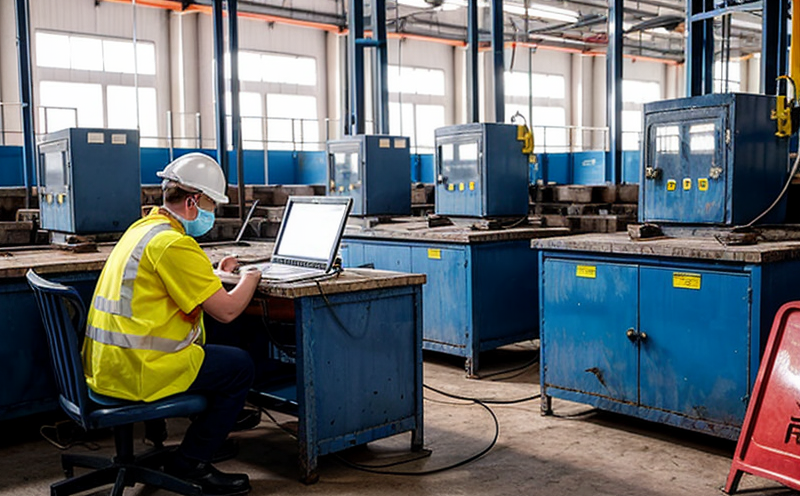ISO 13982 Protective Clothing Testing against Particles
The ISO 13982 standard is a critical benchmark in ensuring that protective clothing provides adequate protection against airborne particles. This test measures the ability of the fabric to filter out various types of particulates, which can be harmful if inhaled during industrial processes or manufacturing tasks.
Industries such as mining, pharmaceuticals, electronics manufacturing, and chemical processing rely on protective clothing to safeguard workers from hazardous materials. The ISO 13982 test is essential for quality assurance and compliance with health and safety regulations. By conducting this test, manufacturers can ensure that their protective clothing meets the stringent requirements set forth by international standards.
The testing process involves exposing a sample of the fabric to a controlled environment where particles are introduced at specific concentrations and sizes. The fabric's ability to filter these particles is then measured using gravimetric or optical methods. This ensures that the protective clothing can effectively protect workers from airborne contaminants, thereby reducing the risk of respiratory issues and other health problems.
For quality managers and compliance officers responsible for ensuring worker safety in industrial settings, this test provides crucial insights into the performance of their protective clothing. R&D engineers can use these results to refine designs and materials, while procurement teams can source appropriate fabrics that meet or exceed the standards set by ISO 13982.
The test is conducted according to strict guidelines outlined in ISO 13982, which specifies the particle sizes, concentrations, and testing methods. This ensures consistency across different laboratories and helps maintain high-quality standards for protective clothing worldwide. Compliance officers should familiarize themselves with these regulations to ensure that their products are up-to-date and compliant.
The importance of this test cannot be overstated in safeguarding worker health and safety. By adhering to ISO 13982, manufacturers can demonstrate their commitment to worker well-being and compliance with global standards.
Industry Applications
The ISO 13982 test is particularly relevant for industries where workers are exposed to airborne particles that could pose significant health risks. Key sectors include:
- Mining, where dust from minerals and chemicals can be inhaled.
- Pharmaceutical manufacturing, where cleanliness of the environment is paramount.
- Electronics manufacturing, where fine particles can affect product quality.
- Chemical processing plants, which involve handling hazardous materials.
In these environments, protective clothing plays a critical role in protecting workers from inhaling harmful substances. By ensuring that this protective gear meets the rigorous standards set by ISO 13982, manufacturers and facilities can significantly reduce the risk of respiratory illnesses and other health hazards.
The test results are used to validate the performance of different types of fabric used in protective clothing. This helps in selecting materials that offer the best protection against specific particle types. For instance, certain fabrics may perform better with smaller particles than others, which is crucial for ensuring worker safety in various industrial settings.
Why Choose This Test
The ISO 13982 test offers several advantages over other methods of testing protective clothing. Firstly, it provides a standardized approach to assessing the performance of fabric against airborne particles. This ensures that results are consistent and comparable across different manufacturers and laboratories.
Secondly, the test is designed to simulate real-world conditions as closely as possible. By subjecting the fabric to controlled environments with specific particle concentrations and sizes, it provides accurate insights into how well the clothing will perform in actual use.
A third advantage of this test is its role in ensuring compliance with international standards. Many industries are required by law to follow these regulations, making ISO 13982 an essential tool for maintaining legal compliance. Failure to meet these standards can result in fines, recalls, and damage to a company's reputation.
Finally, the test helps manufacturers continuously improve their products. By identifying areas where the fabric falls short of expectations, they can make informed decisions about material selection, design changes, and process improvements. This iterative approach ensures that protective clothing remains at the forefront of safety standards.
Use Cases and Application Examples
The ISO 13982 test is widely used in various industries to ensure worker protection against airborne particles. Here are some specific examples:
- Mining Industry: Miners often encounter dust from various minerals, which can cause respiratory issues if ingested.
- Pharmaceutical Manufacturing: Ensuring that the air is free of particles helps maintain the cleanliness required for drug production.
- Electronics Manufacturing: Fine particles in the environment can affect product quality and performance.
- Chemical Processing Plants: Handling hazardous materials requires robust protection against inhalation risks.
In each of these cases, the ISO 13982 test plays a crucial role. It helps manufacturers select appropriate fabrics that meet or exceed the standards set by this international standard. This ensures that workers are adequately protected, reducing the risk of health issues and improving overall safety in the workplace.
The testing process is typically carried out in specialized laboratories equipped with the necessary equipment to simulate real-world conditions accurately. Specimen preparation involves selecting representative samples of the fabric, which undergo rigorous testing using gravimetric or optical methods. The results provide detailed information on the fabric's performance against different particle sizes and concentrations.
These tests are not just theoretical exercises but have practical implications for worker safety. By ensuring that protective clothing meets these standards, industries can significantly reduce the risk of respiratory illnesses and other health hazards associated with inhaling harmful particles.





